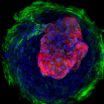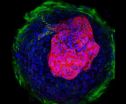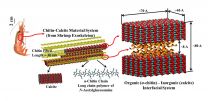(Press-News.org) Berkeley -- Researchers at the University of California, Berkeley, in collaboration with scientists at the Gladstone Institutes, have developed a template for growing beating cardiac tissue from stem cells, creating a system that could serve as a model for early heart development and a drug-screening tool to make pregnancies safer.
In experiments to be published Tuesday, July 14, in the journal Nature Communications, the researchers used biochemical and biophysical cues to prompt stem cells to differentiate and self-organize into micron-scale cardiac tissue, including microchambers.
"We believe it is the first example illustrating the process of a developing human heart chamber in vitro," said Kevin Healy, a UC Berkeley professor of bioengineering, who is co-senior author of the study with Dr. Bruce Conklin, a senior investigator at the Gladstone Institute of Cardiovascular Disease and a professor of medical genetics and cellular and molecular pharmacology at UC San Francisco. "This technology could help us quickly screen for drugs likely to generate cardiac birth defects, and guide decisions about which drugs are dangerous during pregnancy."
Screening for drug toxicity
To test the potential of the system as a drug-screening tool, the researchers exposed the differentiating cells to thalidomide, a drug known to cause severe birth defects. They found that at normal therapeutic doses, the drug led to abnormal development of microchambers, including decreased size, problems with muscle contraction and lower beat rates compared with heart tissue that had not been exposed to thalidomide.
"We chose drug cardiac developmental toxicity screening to demonstrate a clinically relevant application of the cardiac microchambers," said Conklin. "Each year, as many as 280,000 pregnant women are exposed to drugs with evidence of potential fetal risk. The most commonly reported birth defects involve the heart, and the potential for generating cardiac defects is of utmost concern in determining drug safety during pregnancy."
The new milestone comes nearly four months after Healy and other UC Berkeley researchers publicly debuted a system of beating human heart cells on a chip that could be used to screen for drug toxicity. However, that heart-on-a-chip device used pre-differentiated cardiac cells to mimic adult-like tissue structure.
In this new study, the scientists mimicked human tissue formation by starting with stem cells genetically reprogrammed from adult skin tissue to form small chambers with beating human heart cells. Conklin's lab at Gladstone, an independent, nonprofit life science research organization affiliated with UC San Francisco, supplied these human induced pluripotent stem cells for this study.
The undifferentiated stem cells were then placed onto a circular-patterned surface that served to physically regulate cell differentiation and growth.
Location, location, location
By the end of two weeks, the cells that began on a two-dimensional surface environment started taking on a 3D structure as a pulsating microchamber. Moreover, the cells had self-organized based upon whether they were positioned along the perimeter or in the middle of the colony.
Compared with cells in the center, cells along the edge experienced greater mechanical stress and tension, and appeared more like fibroblasts, which form the collagen of connective tissue. The center cells, in contrast, developed into cardiac muscle cells. Such spatial organization was observed as soon as the differentiation started. Center cells lost the expression of octamer-binding transcription factor 4 (OCT4) and epithelial cadherin (E-cadherin) faster than perimeter cells, which are critical to the development of heart tissue.
"This spatial differentiation happens in biology naturally, but we demonstrated this process in vitro," said study lead author Zhen Ma, a UC Berkeley postdoctoral researcher in bioengineering. "The confined geometric pattern provided biochemical and biophysical cues that directed cardiac differentiation and the formation of a beating microchamber."
Could eventually replace animal models
Modeling early heart development is difficult to achieve in a petri dish and tissue culture plates, the study authors said. This area of study has typically involved the dissection of animals at different stages of development to study the formation of organs, and how that process can go wrong.
"The fact that we used patient-derived human pluripotent stem cells in our work represents a sea change in the field," said Healy. "Previous studies of cardiac microtissues primarily used harvested rat cardiomyocytes, which is an imperfect model for human disease."
The researchers pointed out that while this study focused on heart tissue, there is great potential for use of this technology to study other organ development.
"Our focus here has been on early heart development, but the basic principles of patterning of human pluripotent stem cells, and subsequently differentiating them, can be readily expanded into a broad range of tissues for understanding embryogenesis and tissue morphogenesis," said Healy.
INFORMATION:
The National Institutes of Health and a Siebel Postdoctoral Fellowship helped support this research.
Boston, MA - A new study from Harvard T.H. Chan School of Public Health researchers has found that it would be cost-effective to treat 48-67% of all adults aged 40-75 in the U.S. with cholesterol-lowering statins. By expanding the current recommended treatment guidelines and boosting the percentage of adults taking statins, an additional 161,560 cardiovascular-related events could be averted, according to the researchers.
"The new cholesterol treatment guidelines have been controversial, so our goal for this study was to use the best available evidence to quantify the ...
WASHINGTON, DC --July 14, 2015--Multiple species of bacteria working together in healthy guts are responsible for keeping out nasty bacterial invader, Clostridium difficile, a hospital-acquired culprit responsible for 15,000 deaths each year. The study, published this week in mBio, the online open-access journal of the American Society for Microbiology, could lead to tests to predict which hospital patients are at highest risk of infection and better management of infections.
"Hospital-acquired C. difficile infections have bloomed as a problem in the last 10-15 years, ...
High-fat feeding can cause impairments in the functioning of the mesolimbic dopamine system, says Stephanie Fulton of the University of Montreal and the CHUM Research Centre (CRCHUM.) This system is a critical brain pathway controlling motivation. Fulton's findings, published today in Neuropsychopharmacology, may have great health implications. "Our research shows that independent of weight gain and obesity, high-fat feeding can cause impairments in the functioning of the brain circuitry profoundly implicated in mood disorders, drug addiction, and overeating - several states ...
Despite modern chemoradiation therapy it is still very difficult to give reliable prognoses for malignant gliomas. Surgical removal of the glioma is still the preferred method of treatment. Doctors at Universitätsklinikum Erlangen's Department of Neurosurgery have now developed a new procedure for analysing radiological imaging scans which makes it possible to predict the course of a disease relatively precisely. Their findings have now been published in the journal 'Scientific Reports'.*
The Friedlein Grading A/B (FGA/B) classification system - named after the physician ...
HOUSTON - (July 14, 2015) - After Amazon announced plans last week for a day of online retail discounts July 15 comparable to Black Friday, Wal-Mart is launching a rival sale online the same day. Who will win the e-commerce battle? Winning is a matter of consistent superior e-service quality -- not just on one particular day of the year, according to new research from Rice University's Jones Graduate School of Business.
"Increased e-service quality is associated with increased customer satisfaction, which then leads to higher repurchase intentions," said Vikas Mittal, ...
Putnam Valley, NY. (July 14, 2015) - Systemic lupus erythematosus (SLE) is an autoimmune disease that produces autoantibodies and subsequent immune reactions that can lead to a variety of symptoms, including inflammation of the kidneys, or nephritis. When researchers transplanted mesenchymal stem cells (MSCs) derived from human bone marrow into mice modeled with SLE, they found that inflammation was reduced and nephritis "attenuated." They suggested that their study revealed a "novel mechanism" by which the MSCs can regulate the progression of autoimmune diseases such as ...
HOUSTON - (July 14, 2015) - From 2004 to 2010 in Texas, mental illness was the most common reason for the hospitalization of children ages 10-14 while pregnancy/birth was the most common reason for the hospitalization of adolescents ages 15-17, according to researchers at The University of Texas Health Science Center at Houston (UTHealth) Medical School.
The results were published in the July issue of Hospital Pediatrics, a journal of the American Academy of Pediatrics.
"We were surprised by those two findings and the related costs in millions of dollars," said Bethanie ...
WEST LAFAYETTE, Ind. - New research is revealing details about how the exoskeleton of a certain type of deep-sea shrimp allows the animal to survive scalding hot waters in hydrothermal vents thousands of feet under water.
"A biological species surviving in that kind of extreme environment is a big deal," said Vikas Tomar, an associate professor in Purdue University's School of Aeronautics and Astronautics. "And shrimp are a great test case for evolution because you can find different species all over the world living at various depths and with a range of adaptation requirements."
He ...
DURHAM, N.C. -- Hypervigilance to hostility in others triggers aggressive behavior in children, says a new Duke University-led study.
The four-year longitudinal study involving 1,299 children and their parents finds the pattern holds true in 12 different cultural groups from nine countries across the globe.
This pattern is more common in some cultures than others, which helps explain why some cultures have more aggressive behavior problems in children than other cultures, according to the study.
The findings, published online Monday in Proceedings of the National ...
MADISON, Wis. -- A diet that starves triple-negative breast cancer cells of an essential nutrient primes the cancer cells to be more easily killed by a targeted antibody treatment, UW Carbone Cancer Center scientists report in a recent publication.
The study's senior author, Vincent Cryns, professor of medicine at the University of Wisconsin School of Medicine and Public Health, says the study lays the foundation for a clinical trial to see if a low-methionine diet will help improve outcomes in women with "triple-negative" breast cancer.
Methionine is an essential amino ...


